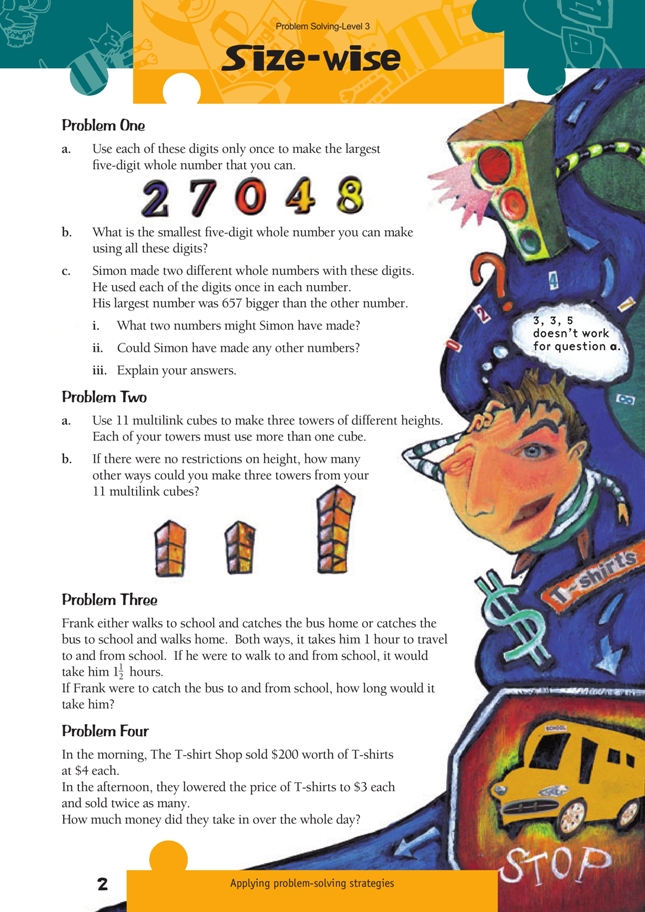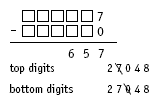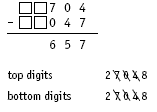These are level 4 number problems from the Figure It Out series.
A PDF of the student activity is included.
Click on the image to enlarge it. Click again to close. Download PDF (280 KB)
use place value knowledge and addition and subtraction to solve problems (Problems 1 and 2)
use simple proportions to solve problems (Problems 3 and 4)
Problem One
Parts a and b require students to apply their knowledge of place value. Arranging the digits in order so that the largest digit is in the place with the highest positional value (10 000), the next largest is in the thousands column, and so on, produces the largest number. This process is reversed to obtain the smallest number. An interesting concept in b is the use of zero as a place holder. Putting zero in the ten-thousands column, as in 02 478, effectively means that it has no place value and therefore does not increase the positional value of the two, as would be the case in 20 478.
Part c is difficult and requires students to think analytically. Trial and improvement is unlikely to be a productive strategy on its own. Since the subtraction answer has only hundreds, tens, and ones digits, only three or four of the five digits are significant.
both digits must be the same
Encourage students to record strategies in the different scenarios that they try. Eliminating digits using an organised list is a useful way to do this. In this method, digits are crossed out as they are used.
Beginning with the ones digits of the answer, 7, gives only two possible arrangements of digits in the ones place.
First possibility:
This leads to a dead end because it is not possible to use the remaining digits to get a difference of five in the tens column.
Second possibility:
Since only three or four digits are involved, the obvious option now is to use seven and zero to end up with six in the hundreds column:
This means that the eight and the two can be reversed to form two possible answers, 28 704 and 28 047 or 82 704 and 82 047.
Problem Two
Students may want to begin by experimenting with multilink cubes to solve this problem. However, using triplets of numbers to represent the tower heights is more efficient. For example, (3, 2, 6) can represent three towers with heights of three cubes, two cubes, and six cubes respectively. Students can then work systematically to find the solution. First establish that (3, 2, 6) is the same triplet as (6, 3, 2) and (2, 6, 3) because order is not important in the problem.
The lowest possible tower is two cubes high, so students can work out different arrangements on this basis:
The middle number cannot be eight or higher because one of the other towers would then have to be one cube. So there are only two possibilities that have two as the lowest tower.
Trying three as the lowest tower gives:
This leads to (3, 4, 4) and (3, 5, 3) – neither of which is allowed because each tower must be a different height.
If we try to have four as the lowest tower, only seven cubes remain to make the other two towers. At least one of these towers would end up being three or less, so no solutions can be found with four as the lowest tower.
Therefore (2, 3, 6) and (2, 4, 5) are the only possible answers.
Part b removes the constraints of having to have different heights and towers that use more than one cube, so the possibilities are all those shown in the answers.
Encourage students to investigate solutions to similar problems, for example, “Make four towers out of a total of 20 cubes”.
Problem Three
In the first instance, students will need to work out how long a one-way walk takes. The walk to and from school takes 11/2 hours, so a one-way walk takes half that amount of time, which is 3/4 hour or 45 minutes. A bus trip one way with a walk the other way takes 1 hour, so a one-way bus trip must take 1 hour minus 3/4 hour (45 minutes), which is 1/4 of an hour (15 minutes). If Frank caught the bus both ways, it would take 2 x 1/4 = 1/2 hour (30 minutes).
Students may enjoy variations on this problem, such as: “Frank travels to school by either walking, cycling, or taking the bus. If he walks to and from school, it takes him 1 hour in total. The bus takes half the time it takes for him to cycle. If he walks one way and buses back, it takes him 40 minutes in total. How long does it take him to cycle to and from school?”
Problem Four
Students need to identify what information is important and what is relevant before attempting to solve the problem. For example, the T-shirt context is irrelevant because the question only relates to the money taken.
$200 worth of T-shirts at $4 each means that 50 were sold in the morning.
Twice as many (100) were sold in the afternoon, at $3 each. $100 x $3 = $300
This means that $200 + $300 = $500 worth of T-shirts were sold over the whole day.
Once students have experienced this type of problem, encourage them to write their own. An example might be: “Jenny sold 40 bags of lollies at $2.50 each in the morning and sold half as many at twice the price in the afternoon. How much money did she take in the day?”
Answers to Problems
1. a. 87 420
b. 02 478 (using 0 as a place holder with no value) or 20 478
c. i. 28 704 and 28 047 or 82 704 and 82 047
ii. Yes – whichever set of numbers you didn’t use for Simon in i
iii. Explanations will vary. One way to do this is to eliminate digits using an
organised list. (See Teachers’ Notes for an example.)
2. a. Only tower heights of (2, 3, 6) and (2, 4, 5)
are possible.
b. (1, 1, 9), (1, 2, 8), (1, 3, 7), (1, 4, 6), (1, 5, 5), (2, 2, 7), (3, 3, 5), and (3, 4, 4)
3. 1/2 hour
4. $500






